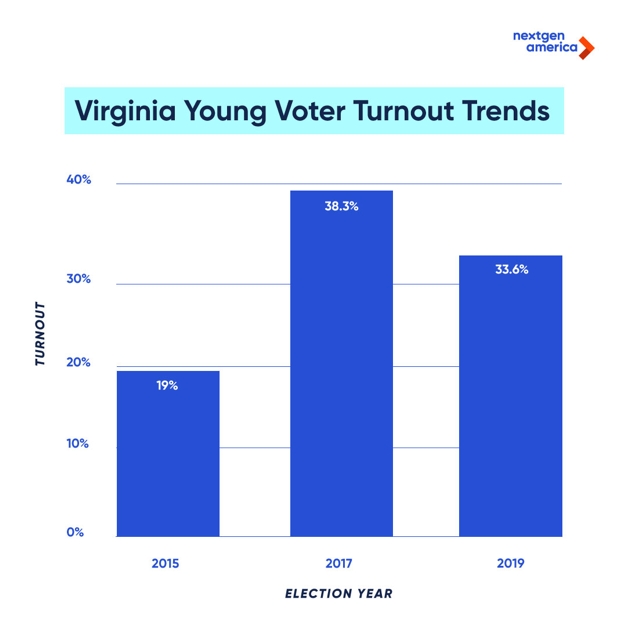NextGen America’s Efforts in the 2019 Virginia Election
NEXTGEN VIRGINIA 2019: BY THE NUMBERS
TOTAL SPEND: $1.1 million
TOTAL STAFF ON THE GROUND: 54
TOTAL GOTV DOORS KNOCKED: 35,750
TOTAL TEXTS SENT: 233,789
TOTAL UNIQUE VOLUNTEERS TAKING ACTION IN 2019: 545
TOTAL VOTERS REGISTERED: 8,442
TOTAL COMMIT TO VOTE CARDS COLLECTED: 10,721
TOTAL CAMPUSES WITH PROGRAM: 18
TOTAL YOUNG VOTERS REACHED WITH DIGITAL ADS: 675,000+
TOTAL PIECES OF DIRECT MAIL SENT: 65,929
The results are in, and it’s clear that young Virginians helped power the Democratic party to historic victories in the State Senate and House of Delegates this fall. When NextGen Virginia began working in Virginia in the summer of 2013, Republicans controlled both chambers of the legislature and the Governor’s mansion. Over the course of six short years, Democrats have been able to capture a progressive trifecta in the Commonwealth, powered by enthusiasm and support from young people and people of color. This massive shift is a true testament to progressive power and the change that can happen when we campaign on issues that matter and utilize smart, effective, peer-to-peer organizing.
The fight is far from over– but momentum is on NextGen America’s side. We’re going to build on what we started six years ago, and go into 2020 ready to beat Donald Trump in Virginia and beyond.
Young Virginians Turned Out to Vote
Early projections confirm that 2019 is likely to have the highest voter turnout in a non-gubernatorial off-year election in Virginia history — and young Virginians are a major reason why. Even before polls opened on Tuesday, Virginians age 18-29 had cast more than 12,000 early votes — more than three times more than 2015’s total, according to political analytics firm Targetsmart. This was the largest increase in early vote turnout of any age cohort and signals continued increased enthusiasm from Gen Z and Millennial voters, who voted 2-to-1 for Democrats in 2018’s midterms.
While there are no exit polls available for Virginia’s elections this year, NextGen tracked turnout in 11 key youth-dense precincts. Across those 11 precincts, turnout increased by more than 14 points over 2015 levels, and approached 2017 gubernatorial election levels.
Turnout Trends from NextGen Virginia’s 11 Target Youth-Dense Precincts:

By looking at the specific takeaways in these 11 precincts, it’s clear that this added turnout added hundreds of votes in key red-to-blue districts like HD28 and SD10:

When the Virginia Board of Elections makes final voter turnout data public, NextGen is confident it will show that youth turnout increased at disproportionately high rates compared to other age groups. For now, the anecdotal evidence from these 11 precincts show that young people were fired up!
NextGen Virginia’s Program Powered Democrats to Victory
After powering huge gains for Virginia Democrats in 2017 legislative elections and 2018’s federal elections, NextGen Virginia spent 2019 helping mobilize young people to propel progressive candidates to victory. Starting in spring of 2019, NextGen Virginia volunteers and staff worked across the commonwealth to register more than 8,000 young people on campuses and in communities to vote. By introducing candidates to young voters, contrasting the candidates on the issues that matter most to young people, and ensuring young people knew when and where to vote, the NextGen field program helped flip the legislature.
Beyond our on-the-ground presence, the NextGen America team reached non-student young people where they’re at: online, on their phones, and even in their mailbox. NextGen’s digital ad program reached more than 675,000 young Virginians in key districts with messages about what’s at stake for the Commonwealth if Democrats win and contrasting candidates on the issues that matter most. Beyond ads, NextGen recruited more than two dozen young “micro-influencers” based in Virginia to talk about how to vote with their audience of followers, including an aspiring model in the Hampton Roads area and a lifestyle blogger in Northern Virginia. Further, NextGen volunteers across the country sent more than 233,000 Get Out The Vote text messages to sporadic voting young progressives in Virginia. Lastly, NextGen sent experiment-informed social pressure mail to 65,000 young voters, giving them more information on how to cast their ballot.
After all that work, it’s clear that key victories for Democrats in toss-up districts were powered in part by NextGen’s program. For example:
- In Richmond-based Senate District 10, Democratic candidate Ghazala Hashmi defeated incumbent GOP Senator Glen Sturtevant, helped by increased turnout from Virginia Commonwealth University and University of Richmond students. NextGen organizers registered at least 858 new voters in SD10 and gathered 2,181 commitments to vote from VCU and Univ. of Richmond students. On Election Night, turnout increased at VCU-based Precinct 505 from 17.5% in 2015 to 35.8% in 2019, more than doubling turnout. In fact, 40 more people cast ballots at Precinct 505 in 2019 than did in the much higher profile 2017 Gubernatorial election.
- In ultra-competitive House of Delegates District 28, progressive millennial candidate Josh Cole claimed the seat for Democrats, helped by students at the University of Mary Washington in Fredericksburg. NextGen registered 448 UMW students in 2019 and got commitments to vote from 581 registered students. Again, turnout nearly doubled over 2015 levels in Fredericksburg City Precinct 201, from 26% to 50%. 921 more votes were cast this year than in 2015, helping lead Cole to a 1036-vote victory.
Many members of the NextGen Virginia team hadn’t been born yet the last time the Democratic party held complete power in Virginia (1993), making this #youthvote victory all the more impressive.
Major Returns on Investments
Through GiveGreen, a partnership between NextGen America and League of Conservation Voters Action Fund, a total of $2.5 million was raised and contributed to State House and State Senate candidates in Virginia in 2019. With some races still too close to call, at least 22 candidates from the GiveGreen slate won their elections on Tuesday.